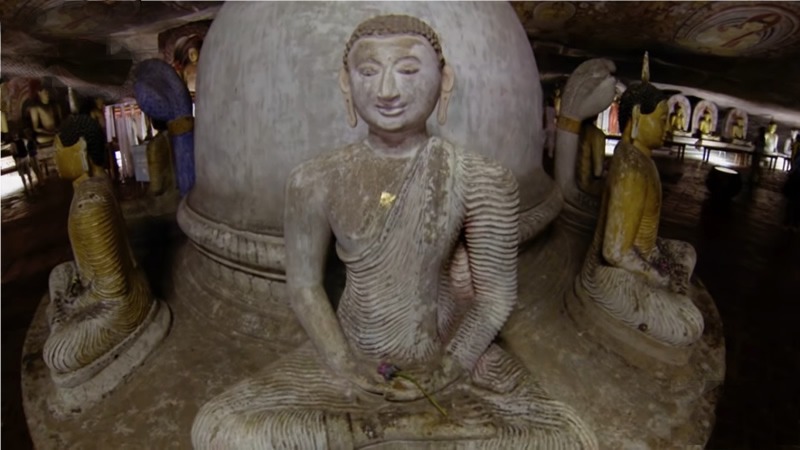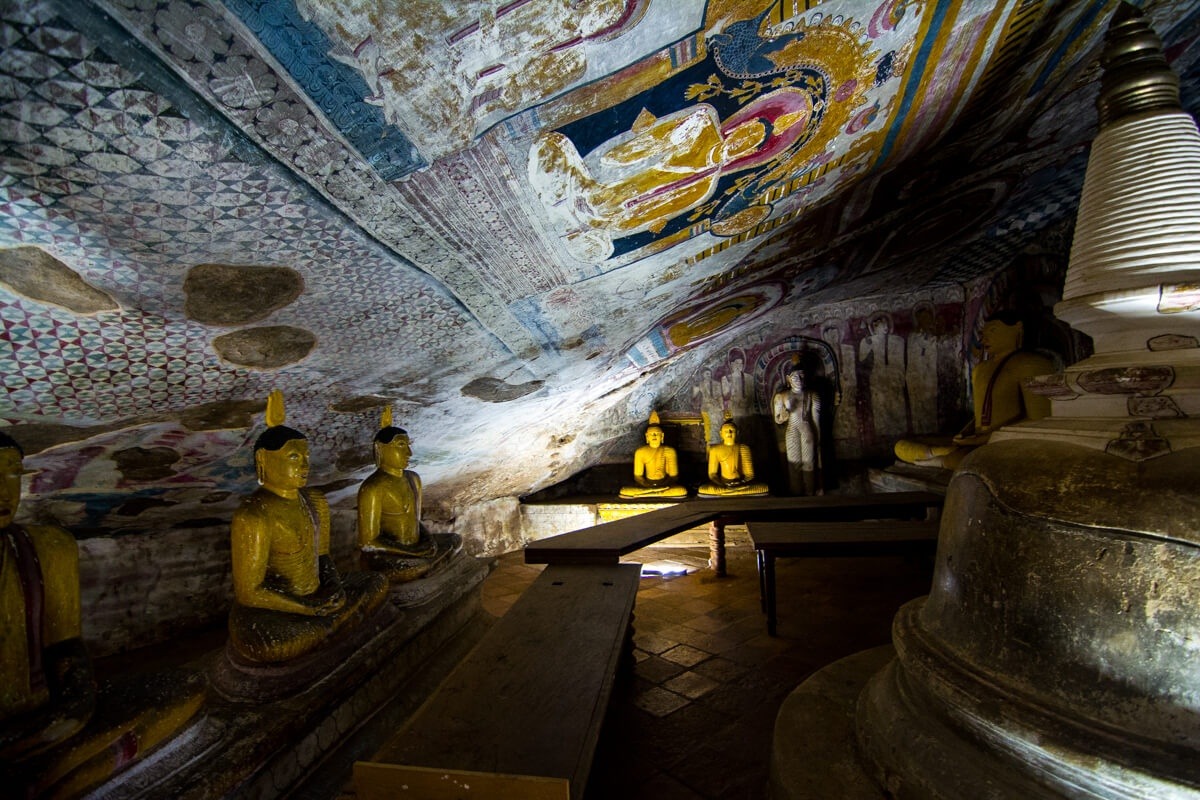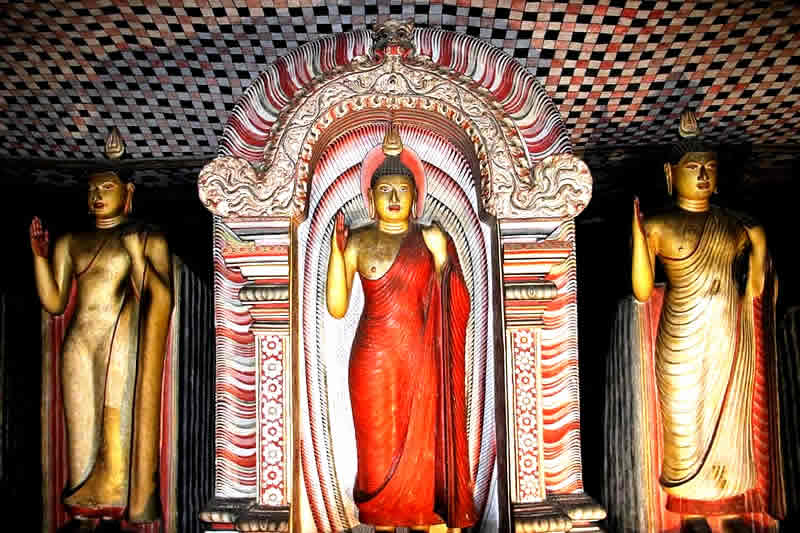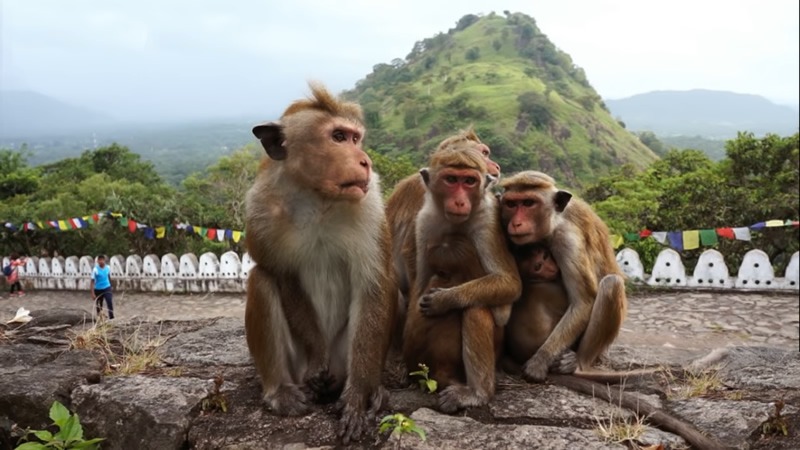
Is This Sri Lanka’s Most Macabre Painting?
The rock cave temple Dambulla better known as Golden temple Dambulla hides some of the world’s most ancient paintings. The temple silt isolation on a mountain and surrounded by thick forest, this temple had been impassable in the past due to its location. Then, why ancient painters in the 1st century BCE, have done such a beautiful painting and frescoes interior of this cave?
Golden cave temple Dambulla
It would seem to be reasonable to contemplate why unknown, ancient artisans had created this beautiful gallery in the golden temple Dambulla, during the reign of King Walagambahu in the 1st century BCE-ever asked why they chose those isolated, hidden caves to carry on their marvellous work.

By the 1st century BCE, Sri Lanka was a country with prosperity, the country had far and wide popularity as a wealthy nation that was echoed in many parts of the world, through the word of foreign visitors. Alas, the prosperity which caused the rising of one of the greatest culture in the regions also brought the ill-fate to the island as it tempted the invaders to take the wealth into their hands.
South Indian invaders vandalize then capital city of Sri Lanka, Anuradhapura in the 1st century BCE, leaving no room to the King Walagambau to make any attempt to gain the kingship immediately.
According to the studies carried out by historians, the king had retreated to isolated jungles and rock cave temple Dambulla had provided shelter to the king. It is believed that King lived more than a decade in the cave and elsewhere, and organized his army. After a successful campaign against the enemies, the King had been able to rescue the country from foreign clutches and later the King had made the rock cave an impressive Buddhist temple with the addition of paintings and statues.
The paintings at Golden temple Dambulla can be divided into few segments based on the time they originated. The paintings are scattered over a large surface, covering interior walls of five caves. “The paintings had undergone many restorations in the past, 12th century King Nissankamalla had restored the fragile paintings and again during the Kandy period in the 18th century,” said Mervin, a guide that helps visitors. “We believe that the paintings of the cave Number 1 are the most ancient paintings, and some of them are in very dilapidated condition despite restoration effort in the recent past” according to Mervin.
Apart from the large collection paintings at rock cave temple Dambulla, there are 153 Buddha statues as well as three statues depicting three kings and four God figures, most paintings are restored, repainted or hidden with a new plaster in order to make new paintings. The paintings and figures of 3rd cave believed to be originated during the Kandyan period (18th century AD), while some of the paintings at cave number 2 believed to be originated after the arrival of colonial rulers in Sri Lanka.
Until the early part of British colonial period, early 18s, only the people in the surrounding village knew about this ring of granite caves with a cycle of hundreds of paintings that expanse over a 2100 square meters of plastered interior walls. It was not a temple that was frequented by Buddhist devotes as there was no proper way of getting into the temple that towers 160 meters above the surrounding area.
The rock cave temple Dambulla comes to fore as a place of an important tourist attraction with the conservation plan carried out from 1982 to 1996 in accordance with UNESCO to protect and revive the historical value of the rock cave temple Dambulla, due to which a considerable improvement on infrastructure and accessibility resulted.

Despite the relative obscurity of rock cave temple Dambulla; it has become one of the most macabre art galleries on the island. Over the last centuries, a considerable number of ancient paintings is fallen away with the plaster while some other paintings are discoloured. But the fate of the remaining paintings is also somewhat chilling.
Rock cave temple Dambulla consists of 5 caves in different sizes and magnificence. The monolithic caves stand on a base of 150-meter high granite rock, are hiding some of the superfluous artistic work of ancient painters and sculptures. Rock cave temple Dambulla is a UNESCO world heritage site and by far the most impressive cave temple on the island.
The access to the temple is granted through the rock-cut steps of Dambulla rock, the climb can be bit strenuous (however it is not as difficult as the climb of Sigiriya rock fortress) therefore the climb of the temple highly recommended for people with good physical fitness.
After reaching the temple that lies towards the western slopes of the jagged mountain, offers a breathtaking view over the surrounding lowland, which includes rice paddies, lakes, patches of forests and isolated small houses. Sigiriya rock fortress which lies about 19 km from the cave temple is clearly visible to the naked eyes on clear days.
Swooping swallows and monkeys are permanent residents of the cave temple; hundreds of nests can be spotted around the caves, while troupes of monkeys are hanging on the wired fence and waiting patiently until the devotees make their offerings with fruit plates, which ultimately make the diet of monkeys.
The largest of all 5 caves is the 2nd cave, which measured to be 52 meters from left to right and the width of the cave is 23 meters while the height of the cave is 7 meters at its highest spot. A large number of paintings, depicting scenery pertaining to Buddhism, Buddha statues, the statues of King Valagmabhu, Nissankamalla as well the figure of the most devoted disciple of Buddha better known as monk Mahinda also can be seen in the cave.

The first cave, which is smaller compared to the second cave, is known as Devaraja Lena or “Cave of the Divine King.” A Brahmi inscription caved on the rock near the first cave confirms the antiquity of the temple. The most impressive artefact of the first cave is the colossal Buddha statues, hewn out of the rock, which is measuring 14 meters in length. The Buddha figure whitewashed many times in the course of its past and presumably received its last coat of paint in the 20th century.
The second cave is the largest and home to 16 standing and 40 Buddha statues as well as live size figures of God Saman and Vishnu, which are often honoured by pilgrims with garlands, and finally, 2 statues representing King Valagambahu and King Nissankamalla, who believed to renovated the temple in the 12th century and gilded 50 Buddha statues as per the inscription near the entrance.
Seerendipity tours organize Sri Lanka cultural triangle tour, which is a 3 days tour and includes all major cultural and historical attraction on the island. The 3 days Sri Lanka trip planned with the visit to Anuradhapura on day one and later visit Sigiriya, Dambulla and Kandy during the course of the tour.

We had the opportunity to visit this nice and ancient temple a few years back while we visited Sri Lanka. Dambulla cave temple is a nice temple and it is well worth visiting it. a lot of paintings and beautiful statues. nice post and well written